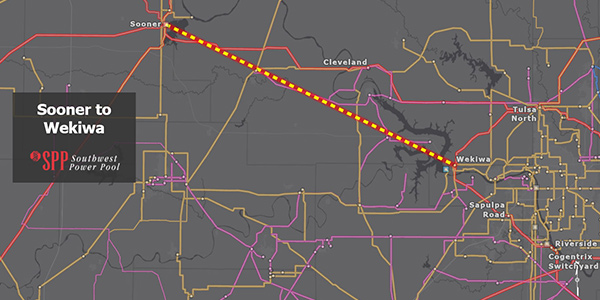Following the awarding of its second competitive project in four years, SPP has begun gathering stakeholder feedback as staff works to again improve its project selection processes under FERC Order 1000.
“We’re trying to mirror this process similar to what we did in 2016,” General Counsel Paul Suskie said during a webinar with stakeholders Friday.
Now, as in 2016, staff will gather member suggestions to improve its Order 1000 processes and other written comments, with a Dec. 29 deadline. The Markets and Operations Policy and Strategic Plan committees will coordinate the information before the January governance meetings, with a task force likely to be formed to present final recommendations to the Board of Directors.
SPP created a similar task force to improve its competitive transmission practices after its first Order 1000 project was canceled because of falling load projections. The task force’s chief recommendation was to allow re-study requests before issuing a notification to construct (NTC), which would have identified the change in load sooner. (See SPP Cancels First Competitive Tx Project, Citing Falling Demand Projections.)
“We knew we had to re-study, but [following the Tariff] we had to wait until the NTC was filed,” said Ben Bright, SPP manager of regulatory processes. He said the task force helped implement about half the 56 suggested stakeholder changes before it was disbanded in 2018.

The Sooner-Wekiwa project, running west of Tulsa | SPP
The board in October approved an industry expert panel’s (IEP) recommendation to grant SPP’s second competitive project, the 75-mile, 345-kV Sooner-Wekiwa project in Oklahoma to Transource Missouri, the panel’s “designated transmission owner. (See Transource Tapped for SPP’s 2nd Competitive Tx Project.)
SPP selects a five-person IEP, based on its expertise in engineering design, project management construction, operations, rate analysis and finance, to evaluate project proposals in those categories. Developer proposals submitted as detailed project proposals under SPP’s transmission owner selection process qualify for incentive points during the scoring.
Five entities — Transource, Xcel Energy Southwest Transmission (the Sooner project’s alternate builder), Liberty Utilities, LS Power-Southwest Transmission, and City Utilities of Springfield (Mo.) — have already submitted 18 proposals and staff added 13 more.
LS Power’s Pat Hayes suggested that the process of granting incentive points is “broken,” given the staff burden to evaluate proposals that number in the hundreds. He called for Tariff revisions requiring the IEP to justify its recommendation according to the projects’ efficacy and costs.
“The goal of the TSOP should be to deliver more efficient and cost-effective projects,” he said. “If it’s causing excessive costs and inefficiencies on SPP staff in the initial stage, we need to do something different. We think the easiest alternative is to scrap the incentive points altogether. There has to be some way to reduce the number of solutions and ideas.”
Bright said that after discussions with engineering support staff, SPP would “probably” recommend the removal of incentive points.
“If there’s a way to improve and provide value, we certainly want to have those conversations,” he said.
Bright said staff is also interested in revising the templates used in project submissions. He said the granular nature of confidential information resulted in a lack of transparency.
“The public version of the reports showed there wasn’t much there [behind the redactions],” he said. “It would be nice to differentiate publicly one proposal from another.”
LS Power and Xcel Energy both proposed changes to the intricate scoring matrix, which resulted in Transource winning the Sooner bid despite turning in the three most expensive proposals. They called for RFP respondents to be provided with details on how the IEP will evaluate and score their submissions.
Other suggested improvements included adding a resiliency metric and offering unsuccessful bidders an opportunity to meet with staff and review the strengths and weaknesses of their proposals.
Affected Systems Issues
Staff also visited with the Seams Steering Committee (SSC) and the Generation Interconnection Users Forum during their meetings last week to gather feedback on SPP’s affected system studies.
Staffer Jon Langford told the SSC that SPP is experiencing a “couple of core issues” in the affected system studies it uses to determine the effects of non-jurisdictional and neighboring interconnection requests on its transmission system. He said neighboring entities, transmission owners and customers have expressed concerns over the RTO’s interconnection queue priorities and the transmission services it studies.
Affected system studies are currently performed when needed and separately from SPP’s GI requests. They account for interconnection requests on neighboring grids, including MISO, Associated Electric Cooperative Inc. (AECI), Minnkota Power Cooperative and Northwestern Energy.
Langford said neighboring transmission providers and planning coordinators typically agree on a defined queue priority in their joint agreements. As an example, he said SPP’s priority practices with AECI are not documented.
“The big questions are those affecting our ability to respond to affected system study requests in a timely manner,” said SPP’s David Kelley, director of seams and Tariff services. “That’s creating disputes and consternation, if you will, from customers on both sides of the equation.”
The committee agreed to revisit the subject at its meeting Jan. 7. Staff hope to have a recommendation to bring before MOPC later in January.
SPP Faced with 3 Planning Studies
Any work on coordinated system studies with MISO and AECI will have to wait, staff told the SSC on Wednesday, as SPP is working on three different transmission planning assessments.

SPP’s planning staff is busy with three different transmission studies. | SPP
“Obviously, there’s a very full workload amongst all of the planning staff. It’s going to be crucial we don’t duplicate work,” SPP’s Neil Robertson said.
Staff are well into work on the 2021 and 2022 studies and the 20-year assessment. The long-term assessment is scheduled to be completed in 2022.



